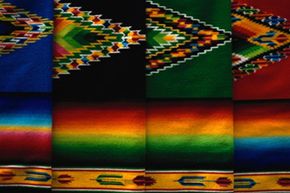Traditional Mexican Clothing
Today, the vast majority of Mexicans dress in a modern, "global" style. But you can still find examples of more traditional Mexican clothing in the many indigenous villages and communities across the country. The best examples of pre-Hispanic clothing are found on women, since men typically wore very little clothing before the Spanish conquest.
Indigenous women dress in several layers. The first is the huipil, a long, sleeveless cloak that resembles a loose dress. Over the cloak, an indigenous woman might wear a quechquemitl, an intricately woven and decorated poncho that was worn exclusively by noblewomen and priests during the Aztec empire [source: Textile Museum]. In many indigenous communities, women wear an ankle-length wrapped skirt held in place by a sash. The final piece of traditional clothing is the rebozo, a length of cloth that wraps around the shoulders and doubles as a coat or baby carrier.
Advertisement
Indigenous men adopted European-style pants and shirts shortly after the Spanish conquest and haven’t strayed much from that uniform ever since. The most unique aspects of male clothing are the serape and the sombrero. The sarape is a multipurpose wool cape that became famous during Mexico’s many wars and armed conflicts during the 19th and early 20th centuries [source: México Desconocido]. The serape functions as a saddle blanket, a sleeping bag and an overcoat in cold or rainy weather. Today, the serape comes in wonderfully ornate designs representing the indigenous roots of the wearer.
The sombrero is an essential article for life in the hot Mexican countryside. The traditional indigenous sombrero is woven from reeds and doesn't have the broad rim of the more ceremonial sombrero charro used by Mariachi. Both indigenous men and women wear leather sandals, and their simple cotton or wool clothing is often embroidered with intricate, colorful patterns that reflect the particular style of the home community. Even the thickness and color of the lines on a rebozo can indicate a person's home village.
Next, we'll talk about the traditional sounds of Mexican culture with an exploration of folk and popular music.
